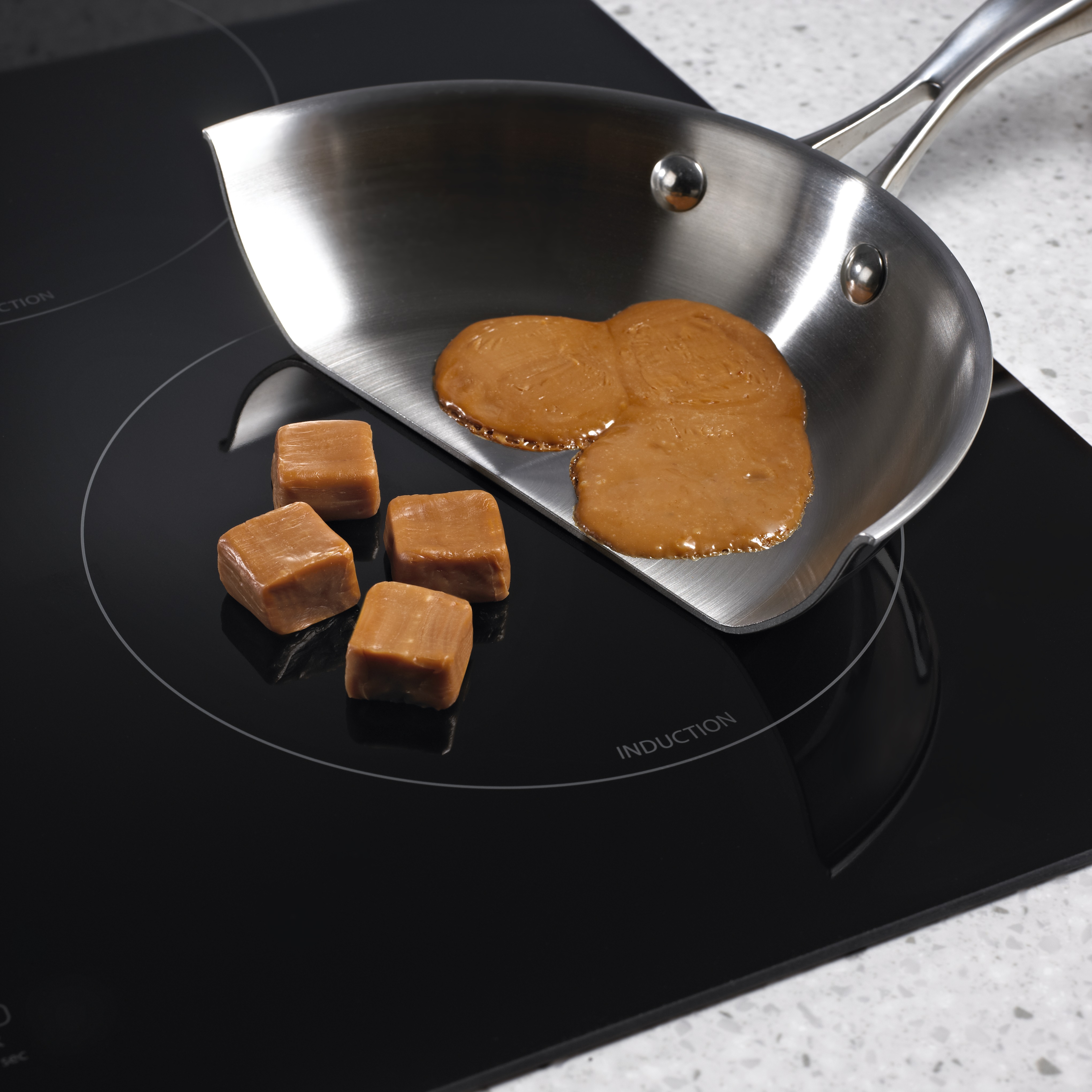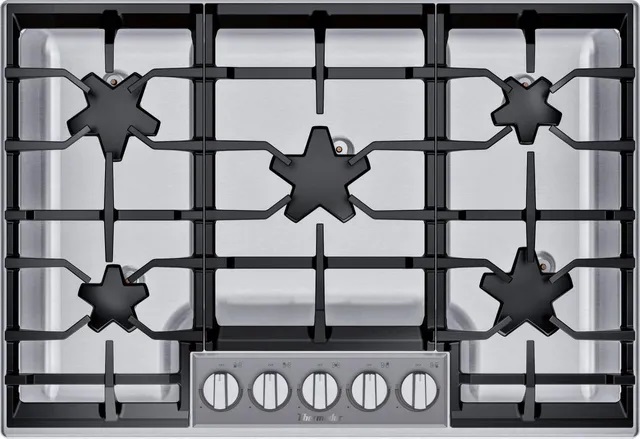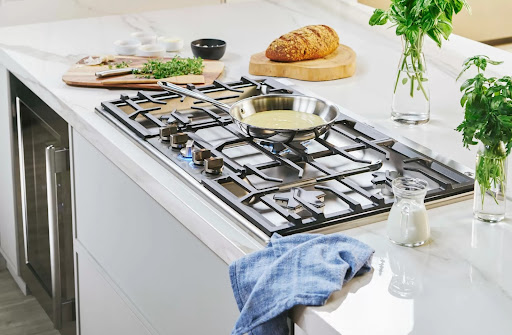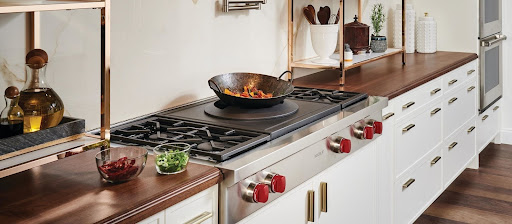
Updated: 01/01/2024
In This Article:
- Ratings
- Built-in Cooking 101
- Cooktop Fuels
- Cooktops vs. Rangetops
- Cooktop Overview
- Rangetop Overview
- Pricing
- Other Features
While the common countertop is accustomed to the coffee maker, toaster, and most recently, the air fryer, the original countertop appliance goes to the cooktop. Though it’s been around for a while, cooktops (and rangetops, as we’ll discuss in this article) are still reshaping the way kitchens function, providing customization and flexible installation that freestanding ranges can’t compete with. To get a better idea of which cooktop you should buy, follow this buying guide.
Ratings
As with all our buying guides, we suggest starting your search with reviews. This provides insight to real buyers who probably have similar needs as you, and who aren’t shy to point out the pros and the cons. The following links will take you to the top-rated cooktops in our catalog:
As always, go into reviews with an open mind knowing buyers are statistically more likely to leave a comment for a negative experience than a positive one, and that products with few reviews overall can suffer a bad rating with just a few negative reviews. In short, use your best judgment and apply what affects you and your needs.
Built-in Cooking 101
Chances are a kitchen with a built-in cooktop also features a complementary wall oven. This unique setup has become a popular alternative to the freestanding range which comes with a cooking surface above and an oven below.
While a range provides an all-in-one cooking center, built-in cooking appliances are considered an upgrade because:
- Built-in cooking appliances provide a sophisticated, clean look that is indicative of luxury.
- Built-in cooking appliances offer buyers the opportunity to customize a kitchen by installing each appliance in optimal zones, while allowing the inclusion of extra appliances, such as a multi-oven or multi-surface cooktop.
With that in mind, it’s also important to note that built-in cooking appliances require professional installation, and that purchasing a wall oven and cooktop separately will cost more than buying a single range.
Cooktop Fuels
Like the foods made on them, cooktops come in a variety of options, the main of which is fuel type. Here’s a general run-through of what to expect from each type:
| Radiant Electric | Induction Electric | Gas | |
|---|---|---|---|
| Basic Overview | A coiled cooking heating element heats the bottom of your pan and in turn the contents therein. | A magnetic field “excites” compatible cookware to heat the entire piece of cookware and the contents therein. | An open flame heats the bottom of your pan and the contents therein. |
| Pros | Sleek appearance, easy cleaning in most cases; lower cost than induction alternatives. | Precise temperature control, no delay in adjustments while cooking; easy cleaning with very little risk of scorching. | Precise temperature control, no delay in adjustments while cooking; similar price to radiant alternatives. |
| Cons | Delayed responsiveness to temperature changes; potential for cooktop scorching. | Most expensive electric option; requires magnetic pots and pans. | Not as sleek as most electric options; more difficult to clean grates and burners. |
| Found On | Cooktops Only | Mostly Cooktops | Cooktops and Rangetops |
| Shop Now | Shop Electric | Shop Induction | Shop Gas |
Which Fuel Source is Best?
Since it’s safer to use, provides precise control, rapid heat response, and a modern look that requires minimal maintenance, induction has risen to the rank as the overall best choice for home cooks. However, if a gas cooktop is being replaced, we recommend sticking to gas since it will offer comparable heat control and precision to induction and will be easier to install into the already existing setup.
In any case, both gas and induction are superior to radiant cooktops, which take notoriously long to heat up and cool down and transfer only a fraction of the heat to the cookware (and the rest to the surface and air). As a result, scorching is easier while slow boils are common, meaning foods need constant monitoring while they cook. But precaution is suggested after cooking, too, since the surface tends to remain hot well after cooking is done.
In comparison, both induction and gas cooktops feature immediate heat response, which means the surfaces start cooling down once the source is cut off. Grates may still be hot a while after cooking (to a lesser degree than a radiant cooktop surface), while induction surfaces are virtually cool the moment a reactive pot or pan is taken off the element.
Other Benefits of Induction
Although gas cooktops offer accuracy and power preferred by restaurant chefs, induction appliances can cook safer, faster, and more efficiently. As mentioned, compatible cookware responds to electromagnets beneath the cooktop surface, “activating” elements within cookware and transferring virtually all of the energy into heat. By doing so, pots and pans are heated uniformly with essentially no cold or hot spots.
That also means that the surface itself is not heating — only the cookware — so it will remain relatively cool to the touch, or as hot as the residual heat given off by the pan. This is directly opposite of gas and electric radiant cooktops which use a hot flame or heating element to transfer heat to a pan.
Besides performance, one of the features users of induction also love is the minimal cleanup. Since the cooktop stays cool, that means boil-overs and spills won’t scorch onto the surface. Take a look at the example below, which shows the difference between caramel cubes on an induction surface that hasn’t been activated versus cubes in a pan responding to electromagnetic waves.

Of course, induction cooktops come with unique considerations. For one, cooking on an induction cooktop requires magnetic-based cookware, which can be a major tradeoff for users of copper, aluminum, and glass cookware. In order to tell if your current cookware is compatible, give them the magnet test — if a magnet sticks to the bottom, the pot or pan can be used on an induction surface.
Secondly, there’s the price. Despite being the newest addition to the lineup of cooktops, induction tends to be the most expensive, notably for its strong list of benefits. This also means homes with a gas line will need to budget for a working 240-volt outlet to supply a new induction cooktop with power. On top of regular installation, most experts recommend a dedicated circuit, which could potentially add to the cost of an existing circuit is tapped out. As mentioned, kitchens with a gas built-in cooking appliance are best off sticking to gas for easier and cheaper installation.
Should I Avoid a Radiant Cooktop?
All in all, radiant cooktops are still high-performing appliances, just with fewer benefits than gas and induction counterparts. Notably, the best benefit of buying an electric cooktop is the price, since they are typically the least expensive models on the market.
Two main things to keep in mind about radiant cooktops are:
- Heating elements cycle on and off to maintain desired heat levels, which results in decreased efficiency and the need for more monitoring.
- Radiant heating elements require time to cool, and therefore should be monitored to avoid injury to others, such as children.
Gas Cooktops
The benefit of cooking with a live flame is that the when a flame is adjusted, it happens in the moment, providing better control of heat. Between gas cooktops, the biggest difference will be how a flame delivers heat. The standard round burner provides a concentric source of heat, but it has often been noted this method can lead to hot and cold spots.
On advanced models, dual ring burners channel flames through and inner and outer ring for enhanced heat coverage. The actual name will vary from brand to brand, but this Bosch gas cooktop with a dual flame center burner is a good example.

Other brands go a step beyond with exclusive burners that deliver even better heat exposure. The patented Star Burners featured in the Thermador gas cooktop below can provide up to 56 percent greater heat coverage than the standard round burner.

Ultimately, gas cooktops come available in a variety of sizes and prices, from budget models to professional-style cooktops and rangetops designed to provide the restaurant experience at home.
Cooktops vs. Rangetops
It’s easy to confuse cooktop and rangetop for the same thing, but in reality, the two are distinct. In short, the main difference comes down to how each is installed. Take a closer look in this comparison chart.
| Type | Cooktop | Rangetop |
| Control Location | Top | Front |
| Installs By | Dropping into a hole in the countertop | Sliding into a cutout space in the counter and cabinet below |
| Fuel Types | Gas, radiant electric and induction | Mostly gas, some induction options |
| Size Range | Available widths range from 12” to 40”, but most commonly sold in 30” and 36” widths | Available widths range from 24” to 60”, but they are mostly commonly sold in 36” and 48” widths |
Cooktop Overview

As shown in the image above, cooktops are designed to fit right into a cutout made in the countertop and are completely surrounded on all sides. Unlike rangetops which use front-control knobs, the dials on a cooktop sit directly on the surface of the appliance. In terms of pricing, cooktops tend to be more affordable than rangetops.
Cooktop Sizes
Excluding smaller models for compact kitchens, the most common cooktop sizes are 30" and 36".
30” cooktop models generally come with four burners, although there are select options with five burners. As for 36” models, most come with six burners, though some may only include five (such as the Thermador model above). Keep in mind, more burners may seem like a better value, but cooking on fully occupied five- or six-burner cooktop can become crowded quickly. The best way to gauge which setup works for you is to bring a piece of cookware into the store and get an in-person idea of how much cooking space a model provides (don’t worry — many people do it).
As far as narrow cooktops, shoppers will primarily find gas and electric options, though select induction models do exist. Two- and four-burner options are ideal for small kitchens or as supplementary cooking zones for larger kitchens and secondary cooking areas, like a basement kitchenette. Look for specialty cooktops, too, including work, steamer, fryer, and grill cooktops.
Cooktop Sizes: Less than 18” | 18” to 30” | 30” | 36” | 40”+
Rangetop Overview

As evident from the image above, the most prominent difference from a rangetop and a cooktop are the placement of the controls, which is due to a design that slides into the countertop rather than dropping into it. This also gives the look of a professional-style range, minus the oven(s) below, and like pro-style ranges, rangetops come with multiple sizes and configurations, including the option for attachments like grills, griddles, or a wok (shown above).
Typically, rangetops are used in larger kitchens as an alternative to a high-end range. Doing so provides the quality of restaurant-grade performance, plus the flexibility to use any combination of wall ovens for a user experience that requires no bending.
In exchange for these benefits, a rangetop usually requires a bigger footprint to work with, and compared to a cooktop and wall oven combination, the price is usually higher.
Rangetops are traditionally gas-fueled, but newer models from brands like Wolf and Signature Kitchen Suite offer dual-fuel models that include cooking surfaces from induction and gas to a built-in sous vide too. More exciting induction rangetops are expected to hit the market in the near future, so make sure to ask your Grand personal sales rep for more information.
Rangetop Sizes
By far, the most popular rangetop sizes are 36” and 48”, but the entire catalog of rangetops vary from as slim as 24” to as wide as 60”. As expected, the bigger the appliance, the greater the opportunity for more burners. For instance:
- A 36” rangetop may come in any combination of six total burners, or four burners, plus a 12-inch griddle or grilling surface.
- A 48” range may come in any combination of eight total burners, or four to six burners, plus supplementary cooking surfaces.
- Even greater flexibility can be found with 60” rangetops, but due to their size, they’re not that popular.
Available sizes: 24” | 30” | 36” | 48” | 60”
Price Range
As with all appliances, prices for cooktops vary depending on size and configuration. Excluding sales and limited-time discounts, the standard 30” to 36” cooktop will price between $500 and $700. This price increases all the way up to $5,000 and more with premium cooktop brands, with the higher-end models being induction and gas models with the latest burner technology like dual ring burners.
Up until the premium price point, electric and gas cooktops will be priced comparably size to size. On the other hand, induction always tends to outprice both gas and electric, even on the ultra-premium end of the price point.
Shop Electric Cooktops by Price
Shop Induction Cooktops by Price
Other Features

Flexible Heating Elements
Versatility is vital to the home cook, which is why many electric and induction cooktops include a flexible heating element that can adjust to several different cookware sizes, and even bridge with adjacent elements to accommodate large pans and trays.
Continuous Grates
Gas cooktops with continuous grates provide a uniform plane where cookware can slide easily from one burner to the next without lifting. Additionally, the flat surface provides better heat contact with the flame.
Touch Controls
While knobs can make a statement, many cooktops are switching to touch controls for their superior look and easy maintenance that requires no more than a wipe of a cloth. On many models, the design also offers the ability to set temperatures to the exact degree rather than estimating with a dial.
WiFi-connected Features
Using WiFi as a tool, smart cooktops are able to facilitate cooking with connected features that sync up with a personal device for remote programming and monitoring. Select connected cooktops can communicate with synced ventilation to activate the moment the cooktop starts, while other allow heat levels to be adjusted from a smart device, essentially giving you power to cook wherever there’s WiFi.
Heat Indicators
An essential for electric cooktops, heat indicators let everyone know the surface of the appliance is hot, which is easier to forget than you’d might think.
Pairing with Wall Ovens
Cooktops are a versatile cooking appliance quickly becoming the new standard in kitchens. To find even more design inspirations, check out these Top 5 Recommended Cooktop Wall Oven Combinations suggested by our experts.
For our full Wall Oven guide, click here: Wall Oven Buying Guide
And for even more possibilities, make sure to check out our entire appliance catalog, with everything from in-stock products to clearance appliances. With 28 appliance showrooms, including locations in Chicago, Indianapolis, Milwaukee, and Green Bay. Shop online, by phone at 888-396-8165, or in-store today!